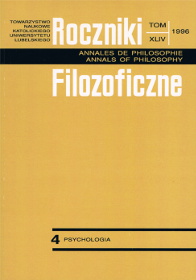The Self-Image and Image of Partner vs Mutual Attractiveness in the Mixed Diad
Abstract
Apparently, an interesting source of interpersonal attractiveness is likeness between the partners of a diad, especially with regard to the self-images and images of partner. This results from the motivating function which self-assessment plays in man's personality. Such an outcome is also suggested by the hitherto studies ⟨Markus, Smith 1981; Karyłowski 1977; Raute-von Wright 1987⟩. Drawing on those suggestions, hypotheses have been formulated, hypotheses which assumed the following source of partners' attractiveness in the mixed diad (woman-man): the observed resemblance between the real self-image and the image of partner (H1); the observed resemblance between the ideal self-image and the image of partner; the influence of the above resemblance on the attractiveness of the partners of the diad is modified by the level of self-acceptance of the perceiving person (H3).
The above hypotheses were then subject to empirical verification. The self-image (real and ideal) and the image of partner were examined by means of the Adjective Check List (ACL) in its new 37-scale version. The Scale of Attractiveness (SKAT) as worked out by Nęcki ⟨1975⟩ was employed to study attractiveness. The subjects were men and women (60 mixed diads), who have known each other for at least two years. The mean age was 26.2 years. The subjects were graduates of secondary schools (62%) or universities (38%). They have been married (48%) or single (52%).
The findings have confirmed the presumed hypotheses. At the same time it turned out that the scope and extent of links between the variables under study differ in the case of the real image (H1) and the ideal image (H2). A likeness between the ideal image and the image of partner makes the field of diad more differentiated and broader in scope. This field, however, has not a structural character, particular aspects of the ideal self-image show no signs of mutual links. A more structurally bound field is the real self-image (cf. tab. 13).
The studies have shown an essential influence of sex on the scope and direction of relations of either variable. That relationship is greater in the subgroup of women, and in their case a likeness between the ideal self-image and the image of partner is more important as regards attractiveness. The level of self-acceptance in the person perceiving resemblance of images is additionally important for attractiveness, especially if that resemblance is perceived by the woman.
In the process of making the partners of the diad more attractive the principle of similarity of images is more important than their complementariness; the latter occurs mainly in relation with a low self-acceptance of the person perceiving similarity of image.
It has also turned out that the very image of partner is a better chosen ground for predicting attractiveness than the similarity of self-images and images of partner (cf.tab. 14).
References
Berscheid E., Walster H.: Physical Attractiveness. W: Advances in Experimental Social Psychology. Vol. 7. New York 1974.
BrehmS. S.: Intimate Relationships. New York 1992.
Cash Th. F., Janda L. H., Byrne D., Murstein B.I., Merighi J. R., Malloy T. E.: Interpersonal Attraction. W: Readings in Social Psychology: General, Classic and Contemporary Selection. Ed. A. Wayne, A. Lesko. Boston 1994.
Dymkowski M.: Samoocena a zmniejszanie atrakcyjności członków własnej grupy. „Przegląd Psychologiczny” 23:1980 nr 1 s. 67-81.
Gough H. G., Heilbrun A. B.: Test Przymiotnikowy ACL: Podręcznik w tł. A.Jurosa i P. Olesia. Lublin 1990 (mps).
Hendrick S. S., Hendrick U.: Liking, Loving and Relating. Lubbock 1992.
Jarymowicz M.: Perception of „Self Others” Dissimilrity and Signs of Attractivenes or Aversiveness of Diversity from Others. „Polish Psychological Bulletin” 13:1982a nr 1 s.39-44.
Jarymowicz M.: Atrakcyjność i awersyjność podobieństwa „ja−inni”. „Przegląd Psychologiczny” 1982b nr 1-4 s.61-74.
Jarymowicz M., Pruszewski W.: O tolerancyjności wobec podobnych i niepodobnych do „ja”. „Przegląd Psychologiczny” 1985 nr3 s.773-778.
Juros A., Oleś P.: Struktura czynnikowa i skupieniowa Testu Przymiotnikowego ACL H. G. Gough'a i A. B. Heilbruna. W: J.Brzeziński, E. Hornowska (red.). Z psychometrycznych problemów diagnostyki psychologicznej. Poznań 1993.
Karyłowski J.: Z badań nad mechanizmami pozytywnych ustosunkowań interpersonalnych. Wrocław 1975a.
Karyłowski J.: Spostrzeganie podobieństwa partnera do „ja” i poziom samoakceptacji a motywacja allocentryczna i sympatia wobec tego partnera. „Studia Socjologiczne” 1975b nr 14 s.19-34.
Karyłowski J.: Koncentracja na sobie i zawartość „ja” idealnego a bezinteresowne działanie na rzecz innych ludzi. „Studia Psychologiczne” 1977 nr16 s.19-36.
Lis-Turlejska M.: Podobieństwo struktur poznawczych partnerów a ich wzajemne postawy wobec siebie. W: S. Mika (red.). Studia nad postawami interpersonalnymi. Wrocław 1975.
Maruyama G., LeCount J.: The Role and Importance of Interpersonal Attraction and Social Acceptance in Educational Settings. W: F. J. Medway, Th.P. Cafferty (eds.) School Psychology: A Social Psychological Perspective. New York 1992.
Markus H., Smith J.: The Influence of Self-schemata on the Percepcion of Others. W: N. Cantor, J. F. Kihlstrom (eds.) Pearsonality, Cognition and Social Interaction. New York 1981.
Nęcki Z.: Psychologiczne uwarunkowania wzajemnej atrakcyjności. Wrocław 1975.
Nęcki Z.: Wzajemna atrakcyjność. Warszawa 1990.
Olszewska-Kondratowicz A.: Techniki kształtowania pozytywnychpostaw interpersonalnych a postrzeganie własnego „ja” i uświadamianie sobie własnych działań. W: S. Mika (red.). Studia nad postawami interpersonalnymi. Wrocław 1976.
Rauste vonWright M., von Wright J.: Obraz własnej osoby a postrzeganie ludzi. „Przegląd Psychologiczny” 1985 nr 3 s.687-698.
Reykowski J.: Obraz własnej osoby jako mechanizm regulujący postępowanie. „Kwartalnik Pedagogiczny” 1970 nr3 s.45-58.
Stroebe W.: Self-esteem and Interpersonal Attraction. W: S. Duck (ed.). Theory and Practice in Interpersonal Attraction. London 1977.
ZiółkowskaB.: Atrakcyjność fizyczna. „Przegląd Psychologiczny” 1994 nr 1-2 s.205-213.
Copyright (c) 1996 Roczniki Filozoficzne

This work is licensed under a Creative Commons Attribution-NonCommercial-NoDerivatives 4.0 International License.





